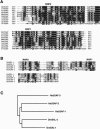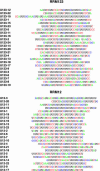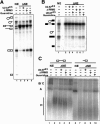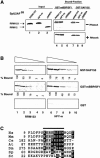The conserved RNA recognition motif 3 of U2 snRNA auxiliary factor (U2AF 65) is essential in vivo but dispensable for activity in vitro
- PMID: 14730023
- PMCID: PMC1370536
- DOI: 10.1261/rna.5153204
The conserved RNA recognition motif 3 of U2 snRNA auxiliary factor (U2AF 65) is essential in vivo but dispensable for activity in vitro
Abstract
The general splicing factor U2AF(65) recognizes the polypyrimidine tract (Py tract) that precedes 3' splice sites and has three RNA recognition motifs (RRMs). The C-terminal RRM (RRM3), which is highly conserved, has been proposed to contribute to Py-tract binding and establish protein-protein contacts with splicing factors mBBP/SF1 and SAP155. Unexpectedly, we find that the human RRM3 domain is dispensable for U2AF(65) activity in vitro. However, it has an essential function in Schizosaccharomyces pombe distinct from binding to the Py tract or to mBBP/SF1 and SAP155. First, deletion of RRM3 from the human protein has no effect on Py-tract binding. Second, RRM123 and RRM12 select similar sequences from a random pool of RNA. Third, deletion of RRM3 has no effect on the splicing activity of U2AF(65) in vitro. However, deletion of the RRM3 domain of S. pombe U2AF(59) abolishes U2AF function in vivo. In addition, certain amino acid substitutions on the four-stranded beta-sheet surface of RRM3 compromise U2AF function in vivo without affecting binding to mBBP/SF1 or SAP155 in vitro. We propose that RRM3 has an unrecognized function that is possibly relevant for the splicing of only a subset of cellular introns. We discuss the implications of these observations on previous models of U2AF function.
Figures









Similar articles
-
Kinetic role for mammalian SF1/BBP in spliceosome assembly and function after polypyrimidine tract recognition by U2AF.J Biol Chem. 2000 Dec 1;275(48):38059-66. doi: 10.1074/jbc.M001483200. J Biol Chem. 2000. PMID: 10954700
-
Structural basis for the molecular recognition between human splicing factors U2AF65 and SF1/mBBP.Mol Cell. 2003 Apr;11(4):965-76. doi: 10.1016/s1097-2765(03)00115-1. Mol Cell. 2003. PMID: 12718882
-
Recognition of RNA branch point sequences by the KH domain of splicing factor 1 (mammalian branch point binding protein) in a splicing factor complex.Mol Cell Biol. 2001 Aug;21(15):5232-41. doi: 10.1128/MCB.21.15.5232-5241.2001. Mol Cell Biol. 2001. PMID: 11438677 Free PMC article.
-
Biochemical and NMR analyses of an SF3b155-p14-U2AF-RNA interaction network involved in branch point definition during pre-mRNA splicing.RNA. 2006 Mar;12(3):410-25. doi: 10.1261/rna.2271406. RNA. 2006. PMID: 16495236 Free PMC article.
-
U2AF homology motifs: protein recognition in the RRM world.Genes Dev. 2004 Jul 1;18(13):1513-26. doi: 10.1101/gad.1206204. Genes Dev. 2004. PMID: 15231733 Free PMC article. Review.
Cited by
-
Multi-domain conformational selection underlies pre-mRNA splicing regulation by U2AF.Nature. 2011 Jul 13;475(7356):408-11. doi: 10.1038/nature10171. Nature. 2011. PMID: 21753750
-
Crystallization and preliminary X-ray analysis of a U2AF65 variant in complex with a polypyrimidine-tract analogue by use of protein engineering.Acta Crystallogr Sect F Struct Biol Cryst Commun. 2006 May 1;62(Pt 5):457-9. doi: 10.1107/S1744309106012504. Epub 2006 Apr 12. Acta Crystallogr Sect F Struct Biol Cryst Commun. 2006. PMID: 16682775 Free PMC article.
-
Identification of motifs that function in the splicing of non-canonical introns.Genome Biol. 2008;9(6):R97. doi: 10.1186/gb-2008-9-6-r97. Epub 2008 Jun 12. Genome Biol. 2008. PMID: 18549497 Free PMC article.
-
Analysis of mutant phenotypes and splicing defects demonstrates functional collaboration between the large and small subunits of the essential splicing factor U2AF in vivo.Mol Biol Cell. 2005 Feb;16(2):584-96. doi: 10.1091/mbc.e04-09-0768. Epub 2004 Nov 17. Mol Biol Cell. 2005. PMID: 15548596 Free PMC article.
-
Structural basis for polypyrimidine tract recognition by the essential pre-mRNA splicing factor U2AF65.Mol Cell. 2006 Jul 7;23(1):49-59. doi: 10.1016/j.molcel.2006.05.025. Mol Cell. 2006. PMID: 16818232 Free PMC article.
References
-
- Abovich, N., Liao, X.C., and Rosbash, M. 1994. The yeast MUD2 protein: An interaction with PRP11 defines a bridge between commitment complexes and U2 snRNP addition. Genes & Dev. 8: 843–854. - PubMed
-
- Bashaw, G.J. and Baker, B.S. 1997. The regulation of the Drosophila msl-2 gene reveals a function for Sex-lethal in translational control. Cell 89: 789–798. - PubMed
-
- Bennett, M., Michaud, S., Kingston, J., and Reed, R. 1992. Protein components specifically associated with prespliceosome and spliceosome complexes. Genes & Dev. 6: 1986–2000. - PubMed
Publication types
MeSH terms
Substances
Grants and funding
LinkOut - more resources
Full Text Sources
Other Literature Sources
Molecular Biology Databases
